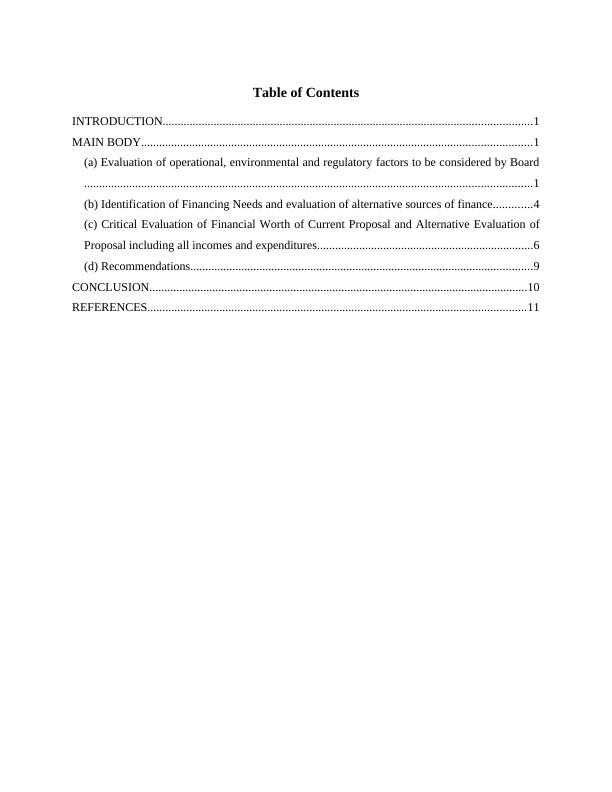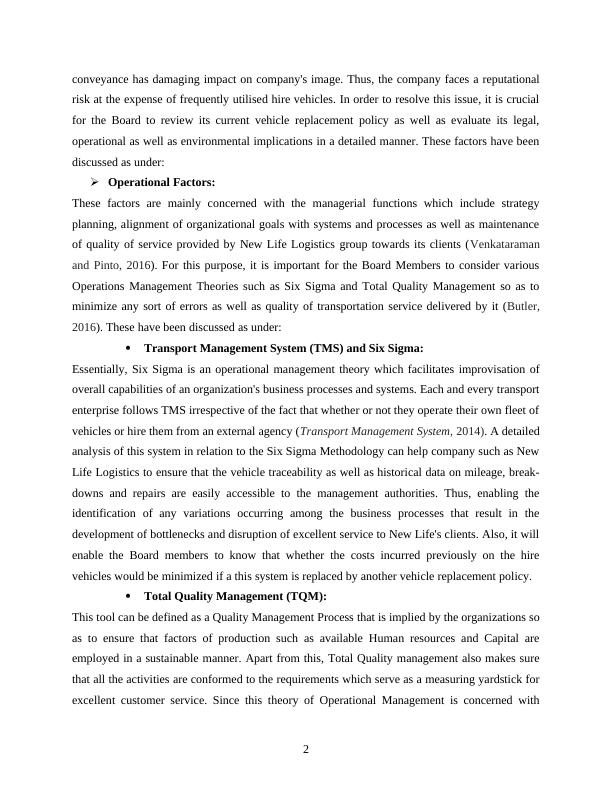INTRODUCTION 1 MAIN BODY1 RECOMMENDATIONS FOR MANAGING FINANCE AND OPERATIONS
Added on 2021-02-19
13 Pages4609 Words277 Views
MANAGING FINANCEAND OPERATIONS

Table of ContentsINTRODUCTION...........................................................................................................................1MAIN BODY..................................................................................................................................1(a) Evaluation of operational, environmental and regulatory factors to be considered by Board.....................................................................................................................................................1(b) Identification of Financing Needs and evaluation of alternative sources of finance.............4(c) Critical Evaluation of Financial Worth of Current Proposal and Alternative Evaluation ofProposal including all incomes and expenditures........................................................................6(d) Recommendations..................................................................................................................9CONCLUSION..............................................................................................................................10REFERENCES..............................................................................................................................11

INTRODUCTIONManagement of Finance and Operations is a crucial component of the overall corporateperformance. This is due to the fact that while finance is mainly related to the accumulation ofvarious sources of funds, operations is related to the actual application of such funding sources.Hence, it is very important for the business to integrate the two functions so as to enhanceenterprise performance in a sustainable manner (Berenguer and Shen, 2019). Effective FleetManagement is mainly concerned with minimization of overall costs through optimum utilisationof resources available to a given corporate organization. Hence, it is important for anorganization to assess the replacement time and methodology for each vehicle so as to derivemaximum benefits on their usage and disposition.This report aims to provide recommendations on the Optimal Vehicle Replacement cyclePolicy for New Life Logistics and Transportation Group PLC. This group is a holding companyof 8 Depots located in South and East UK. The report takes into account Legal and Regulatoryfactors, Operational issues and restrictions, Reputational risk management. Additionally, itprovides a vehicle management policy along with clear statements of budgeted capital andrevenue costs as well as proposed service performance measures.MAIN BODY(a) Evaluation of operational, environmental and regulatory factors to be considered by BoardFor the formulation as well as implementation of a sustainable Vehicle ReplacementPolicy, it is highly essential that one should keep in mind the impact of using an old vehicle inrelation to legal, operational, environmental and regulatory purposes. This is mainly due to thefact that running an old vehicle for long period of time result in an increase in maintenance costsas well as uneconomical fuel consumption on the part of the business entity. In addition to this, itis also the responsibility of the company management to ensure such policy is being followeddiligently across all organizational levels. In the context of given case scenario, it is the policy ofNew Life Group to replace all assets within five years of their usage (Bredmar, 2015). However,it has come to the notice of company's Board Members that this policy has not been fullyadhered to.Currently, New Life Logistics and Transportation Group expends £1,800,000 on hirevehicles annually. However, the management is of the view that heavy reliance on external1

conveyance has damaging impact on company's image. Thus, the company faces a reputationalrisk at the expense of frequently utilised hire vehicles. In order to resolve this issue, it is crucialfor the Board to review its current vehicle replacement policy as well as evaluate its legal,operational as well as environmental implications in a detailed manner. These factors have beendiscussed as under:Operational Factors:These factors are mainly concerned with the managerial functions which include strategyplanning, alignment of organizational goals with systems and processes as well as maintenanceof quality of service provided by New Life Logistics group towards its clients (Venkataramanand Pinto, 2016). For this purpose, it is important for the Board Members to consider variousOperations Management Theories such as Six Sigma and Total Quality Management so as tominimize any sort of errors as well as quality of transportation service delivered by it (Butler,2016). These have been discussed as under:Transport Management System (TMS) and Six Sigma:Essentially, Six Sigma is an operational management theory which facilitates improvisation ofoverall capabilities of an organization's business processes and systems. Each and every transportenterprise follows TMS irrespective of the fact that whether or not they operate their own fleet ofvehicles or hire them from an external agency (Transport Management System, 2014). A detailedanalysis of this system in relation to the Six Sigma Methodology can help company such as NewLife Logistics to ensure that the vehicle traceability as well as historical data on mileage, break-downs and repairs are easily accessible to the management authorities. Thus, enabling theidentification of any variations occurring among the business processes that result in thedevelopment of bottlenecks and disruption of excellent service to New Life's clients. Also, it willenable the Board members to know that whether the costs incurred previously on the hirevehicles would be minimized if a this system is replaced by another vehicle replacement policy.Total Quality Management (TQM):This tool can be defined as a Quality Management Process that is implied by the organizations soas to ensure that factors of production such as available Human resources and Capital areemployed in a sustainable manner. Apart from this, Total Quality management also makes surethat all the activities are conformed to the requirements which serve as a measuring yardstick forexcellent customer service. Since this theory of Operational Management is concerned with2

End of preview
Want to access all the pages? Upload your documents or become a member.
Related Documents
Managing Operations and Finance Assignmentlg...
|16
|5194
|23
Finance & Operations Assignmentlg...
|20
|5485
|41
New Life Drinks- Managing Finance and Operationslg...
|15
|5504
|363
Managing Finance and Operationlg...
|15
|4528
|34
Managing finance And operationlg...
|15
|4736
|168
Green Supply Chain Management Strategies and Practiceslg...
|15
|979
|97